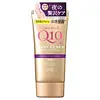What's inside
What's inside
 Key Ingredients
Key Ingredients

 Benefits
Benefits

 Concerns
Concerns

 Ingredients Side-by-side
Ingredients Side-by-side

Urea
BufferingTocopheryl Acetate
AntioxidantWater
Skin ConditioningGlycerin
HumectantParaffinum Liquidum
EmollientCetearyl Alcohol
EmollientDipropylene Glycol
HumectantButyl Octanoate
PerfumingGlyceryl Stearate Se
EmulsifyingGlyceryl Isostearate
EmollientPEG-8 Dimethicone
EmulsifyingXylitol
HumectantStearic Acid
CleansingGlycol Stearate
EmollientAmethyst Powder
AbrasiveGlycine
BufferingPotassium Hydroxide
BufferingEthylcellulose
3-Hydroxybenzoic Acid
Skin ConditioningCI 77492
Cosmetic ColorantCI 77491
Cosmetic ColorantUrea, Tocopheryl Acetate, Water, Glycerin, Paraffinum Liquidum, Cetearyl Alcohol, Dipropylene Glycol, Butyl Octanoate, Glyceryl Stearate Se, Glyceryl Isostearate, PEG-8 Dimethicone, Xylitol, Stearic Acid, Glycol Stearate, Amethyst Powder, Glycine, Potassium Hydroxide, Ethylcellulose, 3-Hydroxybenzoic Acid, CI 77492, CI 77491
Water
Skin ConditioningButylene Glycol
HumectantGlycerin
HumectantTriethylhexanoin
MaskingCetearyl Alcohol
EmollientDipropylene Glycol
HumectantBehenyl Alcohol
EmollientPetrolatum
EmollientParaffinum Liquidum
EmollientHydrogenated Rapeseed Glycerides
EmulsifyingLimnanthes Alba Seed Oil
Skin ConditioningPrunus Amygdalus Dulcis Oil
Skin ConditioningOlea Europaea Fruit Oil
MaskingGlycosyl Trehalose
Emulsion StabilisingTocopherol
AntioxidantPanthenol
Skin ConditioningSodium Hyaluronate
HumectantSimmondsia Chinensis Seed Oil
EmollientUbiquinone
AntioxidantHydrolyzed Collagen
EmollientDisodium EDTA
Acrylates/C10-30 Alkyl Acrylate Crosspolymer
Emulsion StabilisingCarrageenan
Agar
MaskingXanthan Gum
EmulsifyingDimethicone
EmollientSodium Methyl Stearoyl Taurate
CleansingSorbitan Palmitate
EmulsifyingStearic Acid
CleansingPolysorbate 80
EmulsifyingDiisostearyl Malate
EmollientHydrogenated Starch Hydrolysate
HumectantSodium Hydroxide
BufferingPhenoxyethanol
PreservativeMethylparaben
PreservativeParfum
MaskingCaramel
Cosmetic ColorantCI 77492
Cosmetic ColorantWater, Butylene Glycol, Glycerin, Triethylhexanoin, Cetearyl Alcohol, Dipropylene Glycol, Behenyl Alcohol, Petrolatum, Paraffinum Liquidum, Hydrogenated Rapeseed Glycerides, Limnanthes Alba Seed Oil, Prunus Amygdalus Dulcis Oil, Olea Europaea Fruit Oil, Glycosyl Trehalose, Tocopherol, Panthenol, Sodium Hyaluronate, Simmondsia Chinensis Seed Oil, Ubiquinone, Hydrolyzed Collagen, Disodium EDTA, Acrylates/C10-30 Alkyl Acrylate Crosspolymer, Carrageenan, Agar, Xanthan Gum, Dimethicone, Sodium Methyl Stearoyl Taurate, Sorbitan Palmitate, Stearic Acid, Polysorbate 80, Diisostearyl Malate, Hydrogenated Starch Hydrolysate, Sodium Hydroxide, Phenoxyethanol, Methylparaben, Parfum, Caramel, CI 77492
 Reviews
Reviews

Ingredients Explained
These ingredients are found in both products.
Ingredients higher up in an ingredient list are typically present in a larger amount.
Cetearyl alcohol is a mixture of two fatty alcohols: cetyl alcohol and stearyl alcohol. It is mainly used as an emulsifier. Emulsifiers help prevent the separation of oils and products. Due to its composition, it can also be used to thicken a product or help create foam.
Cetearyl alcohol is an emollient. Emollients help soothe and hydrate the skin by trapping moisture.
Studies show Cetearyl alcohol is non-toxic and non-irritating. The FDA allows products labeled "alcohol-free" to have fatty alcohols.
This ingredient is usually derived from plant oils such as palm, vegetable, or coconut oils. There is debate on whether this ingredient will cause acne.
Due to the fatty acid base, this ingredient may not be Malassezia folliculitis safe.
Learn more about Cetearyl AlcoholCi 77492 is also hydrated iron III oxide. It's sole purpose is to give a yellow hue to products.
Iron III oxides are classified as inorganic chemicals for coloring.
Synthetically created Ci 77492 is considered safer than those naturally found. This is because the synthetically created version may contain less impurities. Iron oxides are generally non-toxic and non-allergenic.
Learn more about CI 77492Dipropylene Glycol is a synthetically created humectant, stabilizer, and solvent.
This ingredient helps:
Dipropylene glycol is technically an alcohol, but it belongs to the glycol family (often considered part of the ‘good’ alcohols). This means it is hydrating and gentle on skin unlike drying solvent alcohols like denatured alcohol.
As a masking agent, Dipropylene Glycol can be used to cover the smell of other ingredients. However, it does not have a scent.
Studies show Dipropylene Glycol is considered safe to use in skincare.
Learn more about Dipropylene GlycolGlycerin is already naturally found in your skin. It helps moisturize and protect your skin.
A study from 2016 found glycerin to be more effective as a humectant than AHAs and hyaluronic acid.
As a humectant, it helps the skin stay hydrated by pulling moisture to your skin. The low molecular weight of glycerin allows it to pull moisture into the deeper layers of your skin.
Hydrated skin improves your skin barrier; Your skin barrier helps protect against irritants and bacteria.
Glycerin has also been found to have antimicrobial and antiviral properties. Due to these properties, glycerin is often used in wound and burn treatments.
In cosmetics, glycerin is usually derived from plants such as soybean or palm. However, it can also be sourced from animals, such as tallow or animal fat.
This ingredient is organic, colorless, odorless, and non-toxic.
Glycerin is the name for this ingredient in American English. British English uses Glycerol/Glycerine.
Learn more about GlycerinParaffinum Liquidum is also known as liquid paraffin. It is a type of highly refined mineral oil.
Like other oils, Paraffinum Liquidum has emollient properties. Emollients help soothe and soften the skin. By creating a barrier to trap moisture within, emollients help keep your skin hydrated.
Paraffinum Liquidum does not irritate the skin and is non-comedogenic.
Learn more about Paraffinum LiquidumStearic Acid is a fatty acid. It is an emollient, emulsifier, and texture enhancer.
As an emollient, stearic acid helps soften skin. It aids the skin's protective barrier by preventing water loss. It also provides a gentle cleansing effect without stripping away natural oils.
Stearic acid may also be used to enhance the texture of products. It can add volume and stabilize ingredients such as water and oil. This can help water and oil ingredients from separating.
Sources of stearic acid include animal or vegetable fats/oils such as coconut or shea. It can be naturally found in butter, cocoa butter, shea butter, vegetable fats, and animal tallow.
This ingredient may not be Malassezia folliculitis, or fungal-acne safe.
Learn more about Stearic AcidWater. It's the most common cosmetic ingredient of all. You'll usually see it at the top of ingredient lists, meaning that it makes up the largest part of the product.
So why is it so popular? Water most often acts as a solvent - this means that it helps dissolve other ingredients into the formulation.
You'll also recognize water as that liquid we all need to stay alive. If you see this, drink a glass of water. Stay hydrated!
Learn more about Water